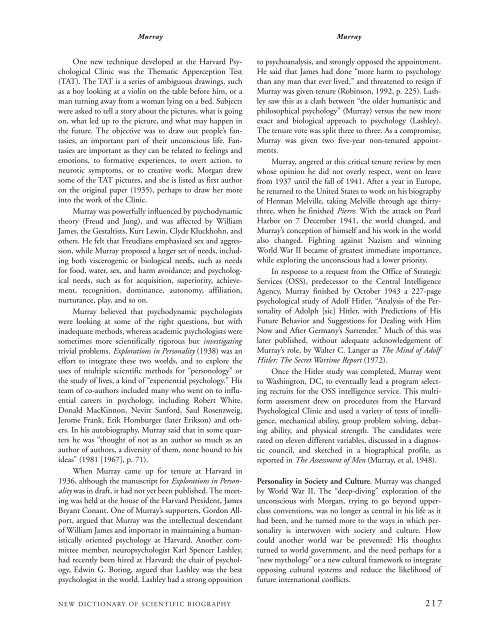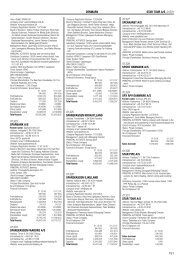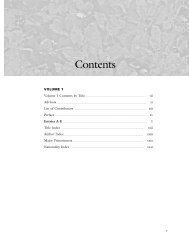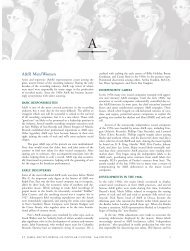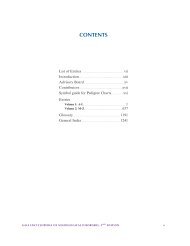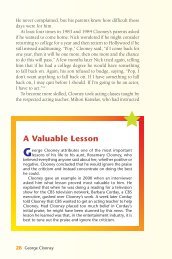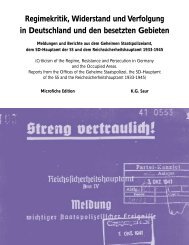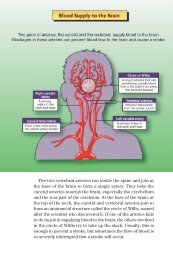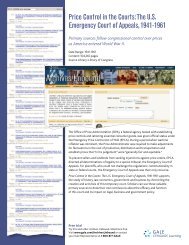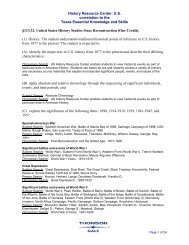MURRAY, HENRY ALEXANDER (b. - Gale
MURRAY, HENRY ALEXANDER (b. - Gale
MURRAY, HENRY ALEXANDER (b. - Gale
Create successful ePaper yourself
Turn your PDF publications into a flip-book with our unique Google optimized e-Paper software.
Murray<br />
Murray<br />
One new technique developed at the Harvard Psychological<br />
Clinic was the Thematic Apperception Test<br />
(TAT). The TAT is a series of ambiguous drawings, such<br />
as a boy looking at a violin on the table before him, or a<br />
man turning away from a woman lying on a bed. Subjects<br />
were asked to tell a story about the pictures, what is going<br />
on, what led up to the picture, and what may happen in<br />
the future. The objective was to draw out people’s fantasies,<br />
an important part of their unconscious life. Fantasies<br />
are important as they can be related to feelings and<br />
emotions, to formative experiences, to overt action, to<br />
neurotic symptoms, or to creative work. Morgan drew<br />
some of the TAT pictures, and she is listed as first author<br />
on the original paper (1935), perhaps to draw her more<br />
into the work of the Clinic.<br />
Murray was powerfully influenced by psychodynamic<br />
theory (Freud and Jung), and was affected by William<br />
James, the Gestaltists, Kurt Lewin, Clyde Kluckhohn, and<br />
others. He felt that Freudians emphasized sex and aggression,<br />
while Murray proposed a larger set of needs, including<br />
both viscerogenic or biological needs, such as needs<br />
for food, water, sex, and harm avoidance; and psychological<br />
needs, such as for acquisition, superiority, achievement,<br />
recognition, dominance, autonomy, affiliation,<br />
nurturance, play, and so on.<br />
Murray believed that psychodynamic psychologists<br />
were looking at some of the right questions, but with<br />
inadequate methods, whereas academic psychologists were<br />
sometimes more scientifically rigorous but investigating<br />
trivial problems. Explorations in Personality (1938) was an<br />
effort to integrate these two worlds, and to explore the<br />
uses of multiple scientific methods for “personology” or<br />
the study of lives, a kind of “experiential psychology.” His<br />
team of co-authors included many who went on to influential<br />
careers in psychology, including Robert White,<br />
Donald MacKinnon, Nevitt Sanford, Saul Rosenzweig,<br />
Jerome Frank, Erik Homburger (later Erikson) and others.<br />
In his autobiography, Murray said that in some quarters<br />
he was “thought of not as an author so much as an<br />
author of authors, a diversity of them, none bound to his<br />
ideas” (1981 [1967], p. 71).<br />
When Murray came up for tenure at Harvard in<br />
1936, although the manuscript for Explorations in Personality<br />
was in draft, it had not yet been published. The meeting<br />
was held at the house of the Harvard President, James<br />
Bryant Conant. One of Murray’s supporters, Gordon Allport,<br />
argued that Murray was the intellectual descendant<br />
of William James and important in maintaining a humanistically<br />
oriented psychology at Harvard. Another committee<br />
member, neuropsychologist Karl Spencer Lashley,<br />
had recently been hired at Harvard; the chair of psychology,<br />
Edwin G. Boring, argued that Lashley was the best<br />
psychologist in the world. Lashley had a strong opposition<br />
to psychoanalysis, and strongly opposed the appointment.<br />
He said that James had done “more harm to psychology<br />
than any man that ever lived,” and threatened to resign if<br />
Murray was given tenure (Robinson, 1992, p. 225). Lashley<br />
saw this as a clash between “the older humanistic and<br />
philosophical psychology” (Murray) versus the new more<br />
exact and biological approach to psychology (Lashley).<br />
The tenure vote was split three to three. As a compromise,<br />
Murray was given two five-year non-tenured appointments.<br />
Murray, angered at this critical tenure review by men<br />
whose opinion he did not overly respect, went on leave<br />
from 1937 until the fall of 1941. After a year in Europe,<br />
he returned to the United States to work on his biography<br />
of Herman Melville, taking Melville through age thirtythree,<br />
when he finished Pierre. With the attack on Pearl<br />
Harbor on 7 December 1941, the world changed, and<br />
Murray’s conception of himself and his work in the world<br />
also changed. Fighting against Nazism and winning<br />
World War II became of greatest immediate importance,<br />
while exploring the unconscious had a lower priority.<br />
In response to a request from the Office of Strategic<br />
Services (OSS), predecessor to the Central Intelligence<br />
Agency, Murray finished by October 1943 a 227-page<br />
psychological study of Adolf Hitler, “Analysis of the Personality<br />
of Adolph [sic] Hitler, with Predictions of His<br />
Future Behavior and Suggestions for Dealing with Him<br />
Now and After Germany’s Surrender.” Much of this was<br />
later published, without adequate acknowledgement of<br />
Murray’s role, by Walter C. Langer as The Mind of Adolf<br />
Hitler: The Secret Wartime Report (1972).<br />
Once the Hitler study was completed, Murray went<br />
to Washington, DC, to eventually lead a program selecting<br />
recruits for the OSS intelligence service. This multiform<br />
assessment drew on procedures from the Harvard<br />
Psychological Clinic and used a variety of tests of intelligence,<br />
mechanical ability, group problem solving, debating<br />
ability, and physical strength. The candidates were<br />
rated on eleven different variables, discussed in a diagnostic<br />
council, and sketched in a biographical profile, as<br />
reported in The Assessment of Men (Murray, et al, 1948).<br />
Personality in Society and Culture. Murray was changed<br />
by World War II. The “deep-diving” exploration of the<br />
unconscious with Morgan, trying to go beyond upperclass<br />
conventions, was no longer as central in his life as it<br />
had been, and he turned more to the ways in which personality<br />
is interwoven with society and culture. How<br />
could another world war be prevented? His thoughts<br />
turned to world government, and the need perhaps for a<br />
“new mythology” or a new cultural framework to integrate<br />
opposing cultural systems and reduce the likelihood of<br />
future international conflicts.<br />
NEW DICTIONARY OF SCIENTIFIC BIOGRAPHY 217


